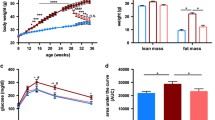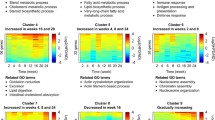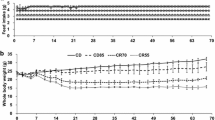Abstract
Objectives:
The aim of this study was to explore the phenotypic differences underpinning obesity susceptibility or resistance based on the metabolic and transcriptional profiling of C57BL/6J mice fed a high-fat diet (HFD).
Methods:
The mice were fed either a normal diet or HFD for 12 weeks. After 6 weeks, the mice on HFD were classified as either obesity-prone (OP) or obesity-resistant (OR) depending on the body weight gain.
Results:
Lipid profiles from plasma and liver significantly improved in OR mice relative to the OP group. Energy expenditure was greater in OR mice than in OP mice, with a simultaneous decrease in body fat mass. Epididymal white adipose tissue (eWAT) and liver were enlarged in OP mice (with visible immune-cell infiltration), but these effects were attenuated in OR mice compared with OP mice. Overall glucose metabolism was enhanced in OR mice compared with OP mice, including homeostasis model assessment for insulin resistance, plasma glucose and insulin concentrations, glucokinase activity and hepatic glycogen. Plasma adipokines and proinflammatory cytokines were upregulated in OP mice, and these changes were attenuated in OR mice. Transcriptomic profiles of eWAT and liver revealed common and divergent patterns of transcriptional changes in OP and OR mice, and pointed to differential metabolic phenotypes of OP and OR mice. There were substantial differences between OP and OR mice in molecular pathways, including atherosclerosis signaling, sperm motility, cAMP-mediated signaling in eWAT; and fibrosis, agranulocyte adhesion and diapedesis, and atherosclerosis signaling in liver.
Conclusions:
Taken altogether, the results provide robust evidence of major divergence in the transcriptomes, phenotypes and metabolic processes between obesity susceptibility and obesity resistance in the HFD-fed C57BL/6J mice.






Similar content being viewed by others
References
Eckel RH, Grundy SM, Zimmet PZ . The metabolic syndrome. Lancet 2005; 365: 1415–1428.
Hill JO, Melanson EL, Wyatt HT . Dietary fat intake and regulation of energy balance: implications for obesity. J Nutr 2000; 130: 284S–288S.
Li H, Xie Z, Lin J, Song H, Wang Q, Wang K et al. Transcriptomic and metabonomic profiling of obesity-prone and obesity-resistant rats under high fat diet. J Proteome Res 2008; 7: 4775–4783.
Joo JI, Oh TS, Kim DH, Choi DK, Wang X, Choi JW et al. Differential expression of adipose tissue proteins between obesity-susceptible and-resistant rats fed a high-fat diet. Proteomics 2011; 11: 1429–1448.
Choi JW, Liu H, Choi DK, Oh TS, Mukherjee R, Yun JW . Profiling of gender-specific rat plasma proteins associated with susceptibility or resistance to diet-induced obesity. J Proteomics 2012; 75: 1386–1400.
Kim DH, Choi JW, Joo JI, Wang X, Choi DK, Oh TS et al. Changes in expression of skeletal muscle proteins between obesity-prone and obesity-resistant rats induced by a high-fat diet. J Proteome Res 2011; 10: 1281–1292.
Wang X, Choi JW, Joo JI, Kim DH, Oh TS, Choi DK et al. Differential expression of liver proteins between obesity-prone and obesity-resistant rats in response to a high-fat diet. Br J Nutr 2011; 106: 612–626.
López IP, Marti A, Milagro FI, Zulet Md Mde L, Moreno-Aliaga MJ, Martinez JA et al. DNA microarray analysis of genes differentially expressed in diet-induced (cafeteria) obese rats. Obes Res 2003; 11: 188–194.
Joo JI, Yun JW . Gene expression profiling of adipose tissues in obesity susceptible and resistant rats under a high fat diet. Cell Physiol Biochem 2011; 27: 327–340.
Malone JH, Oliver B . Microarrays, deep sequencing and the true measure of the transcriptome. BMC Biol 2011; 9: 34.
Guarnaccia M, Gentile G, Alessi E, Schneider C, Petralia S, Cavallaro S . Is this the real time for genomics? Genomics 2014; 103: 177–182.
Yang Y, Smith DL Jr, Keating KD, Allison DB, Nagy TR . Variations in body weight, food intake and body composition after long-term high-fat diet feeding in C57BL/6J mice. Obesity 2014; 22: 2147–2155.
Zhang LN, Morgan DG, Clapham JC, Speakman JR . Factors predicting nongenetic variability in body weight gain induced by a high-fat diet in inbred C57BL/6J mice. Obesity 2012; 20: 1179–1188.
Johnston SL, Souter DM, Tolkamp BJ, Gordon IJ, Illius AW, Kyriazakis I et al. Intake compensates for resting metabolic rate variation in female C57BL/6J mice fed high-fat diets. Obesity 2007; 15: 600–606.
Boon MR, Bakker LE, Haks MC, Quinten E, Schaart G, Van Beek L et al. Short-term high-fat diet increases macrophage markers in skeletal muscle accompanied by impaired insulin signalling in healthy male subjects. Clin Sci 2015; 128: 143–151.
Brøns C, Jensen CB, Storgaard H, Hiscock NJ, White A, Appel JS et al. Impact of short-term high-fat feeding on glucose and insulin metabolism in young healthy men. J Physiol 2009; 587: 2387–2397.
Johannsen DL, Tchoukalova Y, Tam CS, Covington JD, Xie W, Schwarz JM et al. Effect of 8 weeks of overfeeding on ectopic fat deposition and insulin sensitivity: testing the ‘adipose tissue expandability’ hypothesis. Diabetes Care 2014; 37: 2789–2797.
Alligier M, Gabert L, Meugnier E, Lambert-Porcheron S, Chanseaume E, Pilleul F et al. Visceral fat accumulation during lipid overfeeding is related to subcutaneous adipose tissue characteristics in healthy men. J Clin Endocrinol Metab 2013; 98: 802–810.
Poussin C, Ibberson M, Hall D, Ding J, Soto J, Abel ED et al. Oxidative phosphorylation flexibility in the liver of mice resistant to high-fat diet-induced hepatic steatosis. Diabetes 2011; 60: 2216–2224.
Jiang M, Zhang Y, Liu M, Lan MS, Fei J, Fan W et al. Hypermethylation of hepatic glucokinase and L-type pyruvate kinase promoters in high-fat diet-induced obese rats. Endocrinology 2011; 152: 1284–1289.
O'Brien RM, Granner DK . PEPCK gene as model of inhibitory effects of insulin on gene transcription. Diabetes Care 1990; 13: 327–339.
Magnusson I, Rothman DL, Katz LD, Shulman RG, Shulman GI . Increased rate of gluconeogenesis in type II diabetes mellitus. A 13C nuclear magnetic resonance study. J Clin Invest 1992; 90: 1323–1327.
Sutherland C, O'Brien RM, Granner DK . New connections in the regulation of PEPCK gene expression by insulin. Phil Trans R Soc Lond B 1996; 351: 191–199.
Clore JN, Stillman J, Sugerman H . Glucose-6-phosphatase flux in vitro is increased in type 2 diabetes. Diabetes 2000; 49: 969–974.
Takamura T, Misu H, Matsuzawa-Nagata N, Sakurai M, Ota T, Shimizu A et al. Obesity upregulates genes involved in oxidative phosphorylation in livers of diabetic patients. Obesity 2008; 16: 2601–2609.
Do GM, Oh HY, Kwon EY, Cho YY, Shin SK, Park HJ et al. Long-term adaptation of global transcription and metabolism in the liver of high-fat diet-fed C57BL/6J mice. Mol Nutr Food Res 2011; 55: S173–S185.
Pang J, Rhodes DH, Pini M, Akasheh RT, Castellanos KJ, Cabay RJ et al. Increased adiposity, dysregulated glucose metabolism and systemic inflammation in Galectin-3 KO mice. PLoS One 2013; 8: e57915.
Rossmeisl M, Rim JS, Koza RA, Kozak LP . Variation in type 2 diabetes-related traits in mouse strains susceptible to diet-induced obesity. Diabetes 2003; 52: 1958–1966.
Samuel VT, Beddow SA, Iwasaki T, Zhang XM, Chu X, Still CD et al. Fasting hyperglycemia is not associated with increased expression of PEPCK or G6Pc in patients with Type 2 diabetes. Proc Natl Acad Sci USA 2009; 106: 12121–12126.
Kranendonk ME, van Herwaarden JA, Stupkova T, Wd Jager, Vink A, Moll FL et al. Inflammatory characteristics of distinct abdominal adipose tissue depots relate differently to metabolic risk factors for cardiovascular disease. Atherosclerosis 2015; 239: 419–427.
Maury E, Brichard SM . Adipokine dysregulation, adipose tissue inflammation and metabolic syndrome. Mol Cell Endocrinol 2010; 314: 1–16.
Hyduke DR, Lewis NE, Palsson BØ . Analysis of omics data with genome-scale models of metabolism. Mol Biosyst 2013; 9: 167–174.
Mori MA, Liu M, Bezy O, Almind K, Shapiro H, Kasif S et al. A systems biology approach identifies inflammatory abnormalities between mouse strains prior to development of metabolic disease. Diabetes 2010; 59: 2960–2971.
Fernandez CD, Bellentani FF, Fernandes GS, Perobelli JE, Favareto AP, Nascimento AF et al. Diet-induced obesity in rats leads to a decrease in sperm motility. Reprod Biol Endocrinol 2011; 9: 32.
Palmer NO1, Bakos HW, Fullston T, Lane M . Impact of obesity on male fertility, sperm function and molecular composition. Spermatogenesis 2012; 2: 253–263.
Long YC, Zierath JR . AMP-activated protein kinase signaling in metabolic regulation. J Clin Invest 2006; 116: 1776–1783.
Misu H, Takamura T, Matsuzawa N, Shimizu A, Ota T, Sakurai M et al. Genes involved in oxidative phosphorylation are coordinately upregulated with fasting hyperglycaemia in livers of patients with type 2 diabetes. Diabetologia 2007; 50: 268–277.
Dahlman I, Forsgren M, Sjögren A, Nordström EA, Kaaman M, Näslund E et al. Downregulation of electron transport chain genes in visceral adipose tissue in type 2 diabetes independent of obesityand possibly involving tumor necrosis factor-α. Diabetes 2006; 55: 1792–1799.
Rong JX, Qiu Y, Hansen MK, Zhu L, Zhang V, Xie M et al. Adipose mitochondrial biogenesis is suppressed in db/db and high-fat diet-fed mice and improved by rosiglitazone. Diabetes 2007; 56: 1751–1760.
Acknowledgements
This work was supported by the Bio-Synergy Research Project (NRF-2012M3A9C4048818) and the Science Research Center Project (NRF-2015R1A5A6001906) of the Ministry of Science, ICT and Future Planning through the National Research Foundation of Korea.
Author information
Authors and Affiliations
Corresponding author
Ethics declarations
Competing interests
The authors declare no conflict of interest.
Additional information
Author contributions
J-YC performed the experiments, analyzed the data and wrote/edited the manuscript. RAM analyzed the data and wrote the manuscript. E-YK, YJK and YH performed the experiments and reviewed the manuscript. JHYP, KWL, S-JK, JK and JWY designed the study and reviewed the manuscript. M-SC supervised this work and had full access to all the data and therefore takes full responsibility for the integrity of the results and accuracy of the data analysis.
Supplementary Information accompanies this paper on International Journal of Obesity website
Supplementary information
Rights and permissions
About this article
Cite this article
Choi, JY., McGregor, R., Kwon, EY. et al. The metabolic response to a high-fat diet reveals obesity-prone and -resistant phenotypes in mice with distinct mRNA-seq transcriptome profiles. Int J Obes 40, 1452–1460 (2016). https://doi.org/10.1038/ijo.2016.70
Received:
Revised:
Accepted:
Published:
Issue Date:
DOI: https://doi.org/10.1038/ijo.2016.70
- Springer Nature Limited
This article is cited by
-
A combination of rebaudioside A and neohesperidin dihydrochalcone suppressed weight gain by regulating visceral fat and hepatic lipid metabolism in ob/ob mice
Food Science and Biotechnology (2024)
-
Obesity, not a high fat, high sucrose diet alone, induced glucose intolerance and cardiac dysfunction during pregnancy and postpartum
Scientific Reports (2021)
-
Combination of a high-fat diet with sweetened condensed milk exacerbates inflammation and insulin resistance induced by each separately in mice
Scientific Reports (2017)




